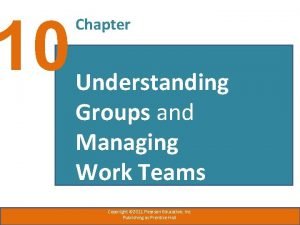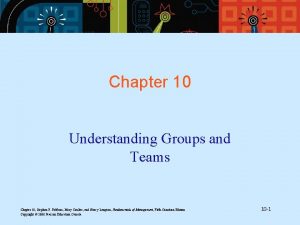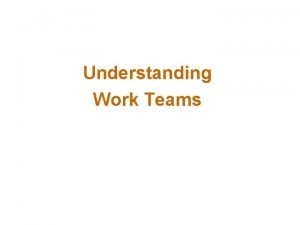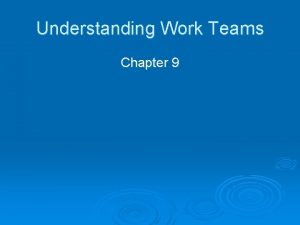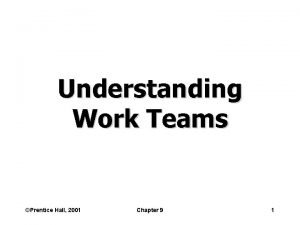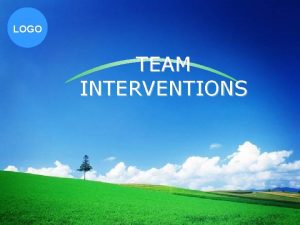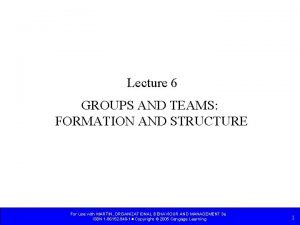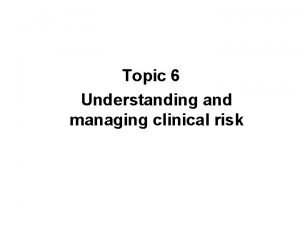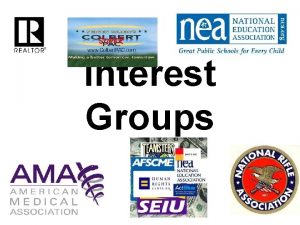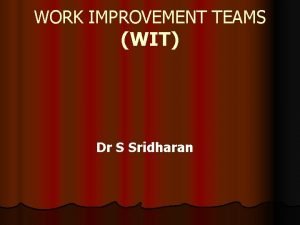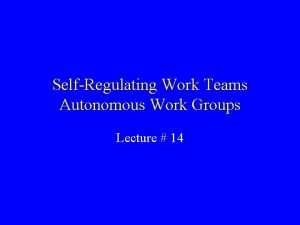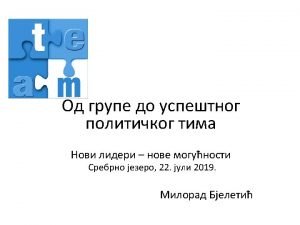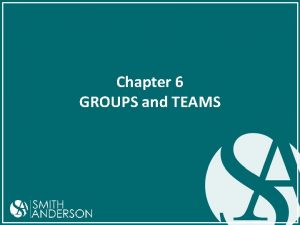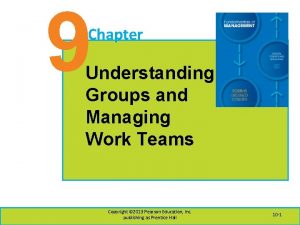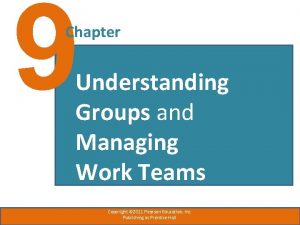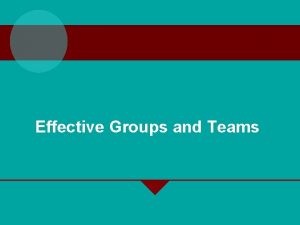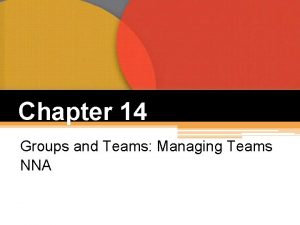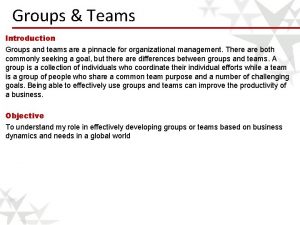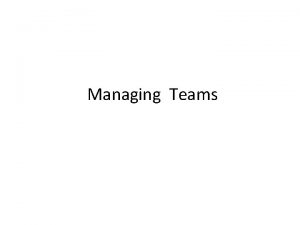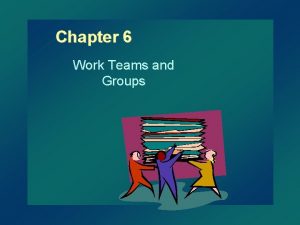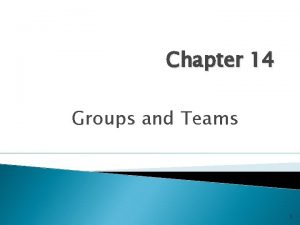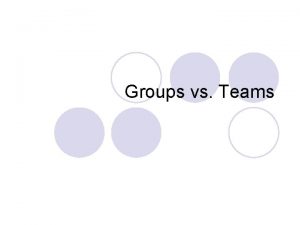10 Chapter Understanding Groups and Managing Work Teams


















- Slides: 18

10 Chapter Understanding Groups and Managing Work Teams Copyright © 2011 Pearson Education, Inc. Publishing as Prentice Hall.

Learning Outcomes • Define a group and describe the stages of group development • Describe the major concepts of group behavior • Discuss how groups are turned into effective teams • Discuss contemporary issues in managing teams Copyright © 2011 Pearson Education, Inc. Publishing as Prentice Hall. 9 -2

What Is a Group? • Group – Two or more interacting and interdependent individuals who come together to achieve specific goals Copyright © 2011 Pearson Education, Inc. Publishing as Prentice Hall. 9 -3

Copyright © 2011 Pearson Education, Inc. Publishing as Prentice Hall. 9 -4

What Are the Stages of Group Development? • Forming Stage – The first stage of group development in which people join the group and then define the group’s purpose, structure, and leadership • Storming Stage – The second stage of group development, which is characterized by intragroup conflict Copyright © 2011 Pearson Education, Inc. Publishing as Prentice Hall. 9 -5

Group Development Stages (cont. ) • Norming Stage – The third stage of group development, which is characterized by close relationships and cohesiveness • Performing Stage – The fourth stage of group development, when the group is fully functional and works on the group task Copyright © 2011 Pearson Education, Inc. Publishing as Prentice Hall. 9 -6

Group Development Stages (cont. ) • Adjourning Stage – The final stage of group development for temporary groups, during which groups prepare to disband Copyright © 2011 Pearson Education, Inc. Publishing as Prentice Hall. 9 -7

Copyright © 2011 Pearson Education, Inc. Publishing as Prentice Hall. 9 -8

What Are the Major Concepts of Group Behavior? • Role – Behavior patterns expected of someone who occupies a given position in a social unit • Norms – Standards or expectations that are accepted and shared by a group’s members Copyright © 2011 Pearson Education, Inc. Publishing as Prentice Hall. 9 -9

What Is Status and Why Is It Important? • Status – A prestige grading, position, or rank within a group Copyright © 2011 Pearson Education, Inc. Publishing as Prentice Hall. 9 -10

Does Group Size Affect Behavior? Large Groups – are good for gaining diverse input Small Groups – Are typically faster at implementation • Social Loafing – The tendency for individuals to expend less effort when working collectively than when working individually Copyright © 2011 Pearson Education, Inc. Publishing as Prentice Hall. 9 -11

How Are Groups Turned into Effective Teams? • 80 percent of Fortune 500 use teams • Teams typically outperform individuals when the tasks require multiple skills, judgment, and experience • Work Teams – Groups whose members work intensely on specific, common goals using their positive synergy, individual and mutual accountability, and complementary skills Copyright © 2011 Pearson Education, Inc. Publishing as Prentice Hall. 9 -12

Types of Work Teams • Problem-Solving Teams – A team from the same department or functional area that’s involved in efforts to improve work activities or to solve specific problems • Self-Managed Work Team – A type of work team that operates without a manager and is responsible for a complete work process or segment Copyright © 2011 Pearson Education, Inc. Publishing as Prentice Hall. 9 -13

Types of Teams (cont. ) • Cross-Functional Team – Teams made up of individuals from various departments and that cross traditional departmental lines • Virtual Team – A type of work team that uses technology to link physically dispersed members in order to achieve a common goal Copyright © 2011 Pearson Education, Inc. Publishing as Prentice Hall. 9 -14

Copyright © 2011 Pearson Education, Inc. Publishing as Prentice Hall. 9 -15

WHAT FACTORS MAKE A TEAM EFFECTIVE? • Adequate Resources – the team’s ability is reduced without adequate resources • Team Leadership and Structure – all members contribute in the work • Trust – Team members must trust each • Performance Evaluation and Reward System – Members have to be accountable both individually and jointly Copyright © 2011 Pearson Education, Inc. Publishing as Prentice Hall. 9 -16

Copyright © 2011 Pearson Education, Inc. Publishing as Prentice Hall. 9 -17

Copyright © 2011 Pearson Education, Inc. Publishing as Prentice Hall. 9 -18
 Understanding groups and teams
Understanding groups and teams Understanding groups and teams
Understanding groups and teams Understanding groups and teams
Understanding groups and teams Turning individuals into team players
Turning individuals into team players Why have teams become so popular
Why have teams become so popular Understanding work teams
Understanding work teams Understanding work teams
Understanding work teams Difference between team and group
Difference between team and group Groups and teams difference
Groups and teams difference Groups and teams difference
Groups and teams difference Managing clinical risk
Managing clinical risk How are ethnic groups and religious groups related
How are ethnic groups and religious groups related Chapter 9 section 3 interest groups at work
Chapter 9 section 3 interest groups at work Reinforcement theory of motivation
Reinforcement theory of motivation Chapter 10 motivating and satisfying employees and teams
Chapter 10 motivating and satisfying employees and teams Section 4 review physical science
Section 4 review physical science Work improvement team
Work improvement team Autonomous work groups
Autonomous work groups Workgroups are characterized by
Workgroups are characterized by
